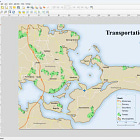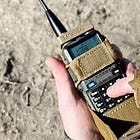Living in a bustling city comes with its own set of thrills; vibrant streets, endless opportunities, and a pulse that never slows.
But urban life also brings unique challenges when disaster strikes.
Whether it’s a sudden power outage, civil unrest, or a natural disaster like a flood, city dwellers need to be prepared to navigate dense environments with limited space and heightened risks.
A well-crafted 72-hour crisis kit tailored for urban apartment living can be your lifeline, offering peace of mind without cluttering your compact space.

In this guide, we’ll walk you through building a discreet, portable, and city-optimized survival kit to keep you safe for three critical days.
Thanks for reading ON SURVIVAL! Subscribe for free to receive new posts and support my work.
Why Urban Dwellers Need a 72-Hour Kit
The Federal Emergency Management Agency (FEMA) recommends having enough supplies to survive independently for at least 72 hours after a disaster, as it often takes this long for emergency services to restore normalcy.
In urban settings, challenges like power outages, blocked roads, or overwhelmed public services can escalate quickly.
Recent blackouts in Spain and Portugal, for instance, saw supermarkets collapse and batteries vanish from shelves within hours, underscoring the need for preparedness.
For apartment dwellers, limited storage and the need to blend into crowded environments make a compact, discreet kit essential.
City-specific risks include:
- Power Outages: Elevators stop, water pressure drops in high-rises, and stores may go cash-only or close entirely.
- Civil Unrest: Dense populations can lead to rapid escalation, requiring quick evacuation or sheltering in place.
- Infrastructure Failure: Contaminated water or disrupted transit can strand you in a concrete jungle.
Your urban survival kit should prioritize portability, multifunctionality, and discretion to address these challenges while fitting seamlessly into your apartment lifestyle.
Core Components of an Urban 72-Hour Kit
A 72-hour kit for city living must balance utility with space constraints.
Store it in a waterproof, easy-to-grab container like a discreet backpack, and refresh supplies annually to ensure food, medications, and clothing remain usable.
Here’s a breakdown of essentials, tailored for urban environments, with Amazon links for compact, high-quality gear.
1. Water and Hydration
Water is your top priority, as city water systems can shut down or become contaminated.
FEMA recommends one gallon per person per day for drinking and sanitation, but carrying three gallons in an apartment is impractical.
Instead, combine bottled water with portable purification solutions.
- Collapsible Water Container: The WaterStorageCube Collapsible Water Container holds 5 gallons when filled but folds flat for storage, perfect for apartment dwellers. It’s lightweight and durable for carrying or storing under a sink.
- Portable Water Filter: The LifeStraw Personal Water Filter is compact and purifies up to 1,000 gallons from questionable sources like public fountains or runoff, ensuring safe hydration on the move.
- Water Pouches: Include a few Datrex Emergency Water Pouches for grab-and-go hydration. Each 125ml pouch is burst-proof and has a 5-year shelf life.
Tip: Store water in multiple small containers to distribute weight and fit into tight spaces like closet corners.
2. Food and Cooking
Non-perishable, no-cook food is critical for urban kits, as cooking may be impossible during power outages or evacuations. Aim for high-calorie, compact options that don’t require refrigeration.
- Emergency Food Bars: SOS Emergency Food Rations provide 3,600 calories per pack, designed for 72 hours. They’re shelf-stable for 5 years and fit easily in a backpack.
- Compact Mess Kit: The GSI Outdoors Glacier Stainless Bottle Cup doubles as a cup and cooking pot, nesting over a water bottle to save space. Pair it with a Portable Stove for boiling water if safe to do so.
Tip: Add protein bars or nuts for morale-boosting snacks, and store food in airtight plastic bags to prevent pests in small apartments.
3. Shelter and Warmth
In urban crises, you may need to shelter in place or evacuate to a public space. Compact, lightweight gear ensures you stay warm and dry without attracting attention.
- Emergency Bivvy: The Tact Bivvy Emergency Sleeping Bag is ultralight and fits in your palm, providing warmth in cold urban nights.
- Poncho/Tarp: A FROGG TOGGS Ultra-Lite2 Rain Poncho doubles as a rain cover and tarp for makeshift shelter, blending in as everyday wear.
- Extra Clothing: Pack a change of clothes, including socks, underwear, and a lightweight jacket, sealed in a waterproof bag. Choose neutral colors to avoid standing out.
Tip: In high-rise apartments, keep a pair of sturdy shoes in your kit for navigating debris-strewn stairwells during evacuations.

AI-Designed Shelters: Building Smart on the Fly
4. Tools and Navigation
Urban environments demand versatile tools for utility and self-defense, plus navigation aids when GPS fails. Multifunctional gear saves space and weight.
- Multi-Tool: The Leatherman Wingman Multi-Tool combines pliers, a knife, screwdrivers, and more in a pocket-sized package, ideal for urban repairs or emergencies.
- Tactical Flashlight: The Streamlight ProTac 1L-1AA is a 350-lumen flashlight with a strobe mode for signaling or disorienting threats, compact enough for everyday carry.
- Physical Map and Compass: A Rand McNally EasyFinder Map of your city, paired with a Suunto A-10 Compass, ensures navigation if cell networks go down.
Tip: Include a small amount of paracord and zip ties for securing gear or creating makeshift repairs.

AI-Powered Resource Mapping
5. Communication and Lighting
Power outages can disable cell networks, and urban blackouts often plunge cities into total darkness. Reliable communication and lighting are non-negotiable.
- Hand-Crank Radio: The RunningSnail Emergency Hand Crank Radio provides AM/FM/NOAA weather updates, a flashlight, and a USB charger, powered by cranking or solar energy.
- Power Bank: The Anker PowerCore 10000 is a slim, high-capacity battery pack to keep your phone alive for emergency calls or navigation.
- Glow Sticks: Cyalume SnapLight Glow Sticks provide 12 hours of light without batteries, perfect for marking your location or signaling.
Tip: Store a printed list of emergency contacts and local radio frequencies in a waterproof bag, as phones may fail

Portable Ham Radios: Your Emergency Lifeline
6. First Aid and Hygiene
Injuries or sanitation issues can escalate in urban crises, especially in crowded or debris-filled environments. A compact first aid kit and hygiene supplies are critical.
- First Aid Kit: The First My Family Compact First Aid Kit includes bandages, antiseptics, and trauma supplies in a small pouch, tailored for urban emergencies.
- Hygiene Essentials: Pack travel-sized Wet Ones Antibacterial Wipes, a toothbrush, toothpaste, and hand sanitizer. Include feminine hygiene products or diapers if applicable.
- Dust Mask: A 3M N95 Respirator protects against dust or smoke, common in urban disasters like building collapses or fires.
Tip: Add over-the-counter medications (pain relievers, antacids, anti-diarrhea) and a 7-day supply of prescriptions, stored in a waterproof pouch.
7. Personal Documents and Cash
Power outages or evacuations can disrupt digital access to IDs or funds. Physical copies and cash are vital for urban survival.
- Document Copies: Store photocopies of your ID, passport, and insurance in a Waterproof Document Pouch. Include a USB with digital backups.
- Cash: Keep $50–$100 in small bills and coins for vending machines, payphones, or cash-only stores.
Tip: Seal documents and cash in airtight bags to protect against water damage during floods or rain.
8. Discreet Bag
Your kit’s container is as important as its contents. In urban settings, a tactical-looking bag can attract unwanted attention, so opt for a nondescript backpack that blends in.
- Discreet Backpack: The North Face Borealis Backpack is a 28L, urban-friendly bag with a sleek design that doesn’t scream “survivalist.” It’s durable, water-resistant, and fits all your gear.
- Tactical Belt for Quick Access: A 5.11 Tactical Maverick Assaulters Belt keeps essentials like a multi-tool or flashlight accessible without digging through your bag, ideal for fast-paced urban movement.
Tip: Choose a bag with reflective strips for visibility at night, but avoid bright colors that stand out in a crowd.
Customizing for Your Urban Environment
Every city has unique risks—coastal floods in Miami, earthquakes in San Francisco, or blizzards in Chicago.
Tailor your kit to your locale:
- High-Rise Dwellers: Add a Silcock Key to access building water valves and extra water storage for potential pressure drops.
- Cold Climates: Include Hand Warmers and a heavier sleeping bag for winter outages.
- Hot Climates: Prioritize extra water and a Cooling Towel to manage heat stress.
- Families with Pets or Babies: Pack pet food, pet emergency kit, a collapsible bowl, or baby supplies like diapers and formula in resealable bags.
Blending In: The Art of Urban Discretion
In a city crisis, standing out can make you a target. Civil unrest or looting can escalate quickly, and a flashy “prepper” bag might draw unwanted eyes.
Choose gear in neutral colors (black, gray, navy) and avoid military-style designs.
Your backpack should look like it belongs to a commuter or student, not a survivalist.
Practice carrying your kit to ensure it’s manageable on foot or public transit, as urban evacuations often involve crowded subways or long walks.
Maintaining Your Kit
A 72-hour kit isn’t a “set it and forget it” solution. Check it twice a year—when you change your clocks is a good reminder.
Replace expired food, update medications, and ensure clothing fits.
Store your kit in a dry, accessible spot, like a closet near your apartment’s exit, and keep a smaller version in your car or workplace if possible.
Final Thoughts
Building an urban 72-hour survival kit is about more than gear—it’s about empowering yourself to face the unpredictable with confidence.
In a city, where chaos can amplify quickly, a compact, discreet, and well-thought-out kit ensures you’re ready to shelter in place or evacuate without missing a beat.
Start small, prioritize essentials, and customize for your environment.
With the right tools, you’ll have peace of mind knowing you’re prepared for whatever the urban jungle throws your way.
Have tips for urban preparedness or favorite gear?
Share them in the comments below, and let’s keep the conversation going.
Stay safe, stay ready, and subscribe for more practical survival guides!
Building Your Survivalist Book Library: Essential Reference Books for a Grid-Down World
·
6 May

In a world where the power grid fails and the internet goes dark, knowledge becomes one of your most valuable assets.
Thanks for reading ON SURVIVAL! Subscribe for free to receive new posts and support my work.
